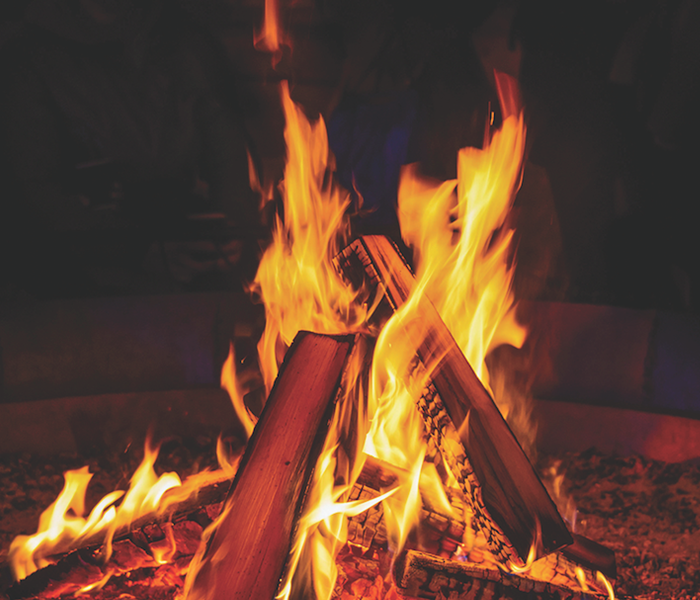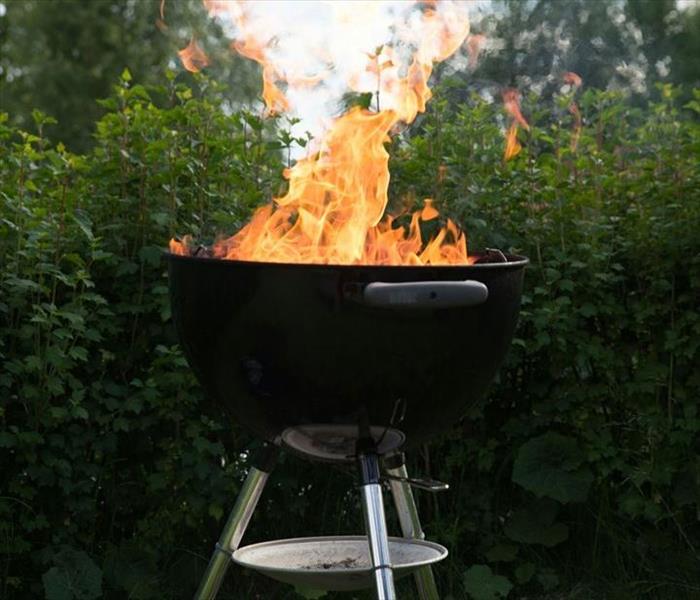Recent Fire Damage Posts
smoke damages that can happen to your house
9/20/2022 (Permalink)
Some San Luis Obispo homeowners could not tell you what smoke damage can do to their homes, let alone what differences exist between various types of smoke after a fire near them. Our trained technicians have the expertise and the education to quickly access your property following a fire to make determinations such as the type of smoke damage to ensure the appropriate equipment is brought on site to restore the home quickly.
When it comes to understanding the difference between smoke types when you experience fire damage in your home won’t help you resolve the situation any quicker, but it can help to narrow it down for those experienced enough in restoration to make a significant difference fast.
Wet smoke damage produces considerable smoke, which can seep into fabrics, furniture, and other areas not directly impacted by the spread of the fire itself.
Dry smoke is often the opposite, with its cause coming from rapidly spreading fires burning at very high heat. The spread of this situation produces a thinner smoke and a powdery residue. While much of the unaffected surfaces can get cleaned with traditional solvents and detergents, these types of fires often require our SERVPRO professionals to utilize controlled demolition techniques to prepare the area for reconstruction.
SERVPRO OF San Luis Obispo will help you with your fire damage
9/20/2022 (Permalink)
A fire on your property can create destructive and violent results. Even though the damage is large or small, you never hear a homeowner say that they are happy it happened to them.
Our technicians at SERVPRO of San Luis Obispo arrive on site quickly and give you the benefit of having a company with certified technicians working for you. Extensive damage created from the fire; professional restoration services is your best choice. Here at SERVPRO of San Luis Obispo we make sure to return your home to a quality pre-damage condition in the quickest most efficient way possible. Especially with smoke since it can reach into cracks and crevices throughout your home, leaving soot residues behind, staining surfaces, and causing odors to damage a variety of materials within your home. We use specialized deodorization and cleaning methods designed to restore your property. Our technicians will help you manage your insurance paperwork and communicate with your insurance company on the restoration of your home.
Damages of soot and smoked materials in the property
2/28/2022 (Permalink)
Damage may be spread by the suspended smoke and soot particles in the air - they are attracted to cold surfaces and will often travel away from the fire source and settle on colder surfaces, such as walls that border the exterior of a building or the top corners of a room. This is always why you see the black ‘soot webs’ after fires, which is not spider webs covered in soot but is in fact only soot particles that have ionized together into a web-like form in a colder area of the structure.
Once soot particles combine with atmospheric water vapor, it becomes acidic, which can be very corrosive to any material surfaces. Neutralization of acid residues is a fundamental procedure to early forms of corrosion prevention.
Because smoke and soot are very invasive and can penetrate various cavities in a structure, HVAC systems and their ductwork can be a concern after a fire. Often, ductwork already contains dust and debris collection, which soot can attach to and contaminate. This causes odor as well as corrosive damage to the material surfaces.
Safety Tips for Christmas
11/2/2021 (Permalink)
 Christmas Tree Safety Tips
Christmas Tree Safety Tips
Local SERVPRO® restoration specialist cautions San Luis Obispo homeowners to take common sense precautions throughout the holiday season San Luis Obispo, CA, Powers says while four out of five Christmas tree fires happen in December and January, the 10 days with the highest average number of fires were all after Christmas Day.
“For many families, preparing for the holiday season is a very busy time,” said Powers. “Come December 26, it’s tempting to relax and stop watering the Christmas tree, replacing bulbs in outdoor lights, and tucking indoor garlands back into place. Dry greens, open sockets and decorations that slip dangerously close to light sockets or fireplaces can all increase the risk of fire in the days after the Christmas holiday.”
According to published reports of the National Fire Protection Association, a confirmed average of 111 fires per year in the U.S. were ones in which a cut tree was the first item ignited in a residential fire. During the same period of the report, an average of 28 million cut Christmas Trees were displayed. Divide 111 by 28 million. You get 0.0000039. Or 0.0004% rounded up. But watching local news reports on the topic, one would think it happened all the time.
Another item in the NFPA report you might find interesting is that fire officials state clearly that artificial trees also catch on fire every year. There is no testing lab or standards for those products to meet to print the words "flame retardant" on their packaging. They're just words on a box. Fake trees catch on fire every year. Not very many, just like farm-grown trees. However, according to the NFPA report, 28% confirmed residential fires where a Christmas tree was the first item ignited involved a fake tree
As the holiday season moves into full swing, Powers reminds homeowners to take common sense precautions based on a clear understanding of the potential danger to help prevent holiday traditions from turning into a holiday nightmare. For more fire prevention tips and information about fire and water damage restoration services, please visit www.SERVPRO.com. For more information on SERVPRO of San Luis Obispo, please contact Joseph Powers at (805) 541-1271.
www.treetowne.com/christmas-tree-safety.
Different kind of extinguishers for different types of fires.
7/20/2021 (Permalink)
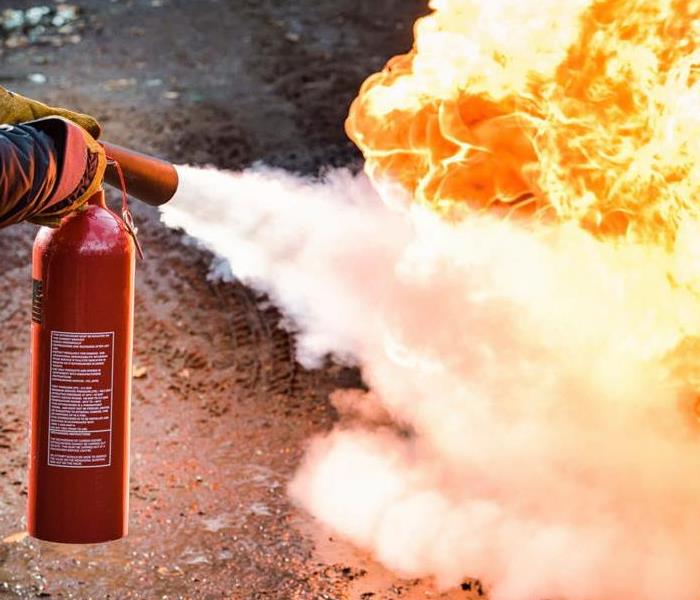 Fire Extinguishers
Fire Extinguishers
Fires are some of the most devastating forces of nature a home, household, or business can face. Regardless, if a kitchen fire incident or falling asleep with a lit cigarette, your home or business can sustain serious damage. These happen to be some the most common fire damage types you will face in the U.S.
Class A
Involving solid combustible materials such as wood, paper, cloth, trash, or plastic, Class A fires are the most common types of fire. In addition to being the most common fire. To do so, it is recommended to use a water or foam fire extinguisher, or water to douse the fire.
Class B
Class B fires involve flammable and combustible liquids such as gasoline, alcohol, oil-based paints, lacquers. Therefore, extinguishers with a B rating are designed to extinguish fires involving flammable and combustible liquids.
Note: Do not attempt to extinguish a fire involving flammable gas unless there is reasonable assurance the source of fuel can be promptly shut off. In fact, if the only fuel burning is the leaking gas, the best method for extinguishing the fire is to shut off the fuel supply. Extinguishing a flammable gas fire, without shutting off the fuel, will allow unburned gas to escape into the atmosphere, which may permit a dangerous accumulation of gas to develop, and an explosion may occur if the gas is exposed to an ignition source.
Class C
Class C fires require a source of electricity. Therefore, they may be started by old wiring, worn-out breaker boxes, frayed electrical cords, or faulty appliances. Then, if possible, extinguish the flames using a carbon dioxide or dry powder fire extinguisher. Do not use water or foam to put out an electrical fire, as both materials can conduct electricity and potentially make the situation more dangerous.
Class D
Most rare among each class of fire, Class D fires can happen when metal ignites. This typically requires high levels of heat and is most common when alkali metals such as potassium, magnesium, aluminum, and sodium are exposed to air or water. Although you are unlikely to encounter a Class D blaze in your home, it is advised that such fires be extinguished with a dry powder extinguisher only.
Class E
Results from the factors found in both Class A and Class B fire damage. The difference being this class introduces electrical elements onto the list. This makes fighting the fire and the resulting damage vary from that in Class A and B.
Class F
A fire that results from the cooking of oils and fats. These fires are significantly hotter and pose more severe damage than those found in Class B.
Class K
Class K fires involve vegetable oils, animal oils, or fats in cooking appliances. Extinguishers with a K rating are designed to extinguish fires involving vegetable oils, animal oils, or fats utilized in commercial cooking appliances.
Note: Extinguishers with a K rating are normally required where deep-fryers and/or griddles are utilized to prepare large quantities of food. An example would be a commercial kitchen similar to those found in restaurants and cafeterias.
San Luis Obispo Fire Damage Company Helps Manage Insurance
7/20/2021 (Permalink)
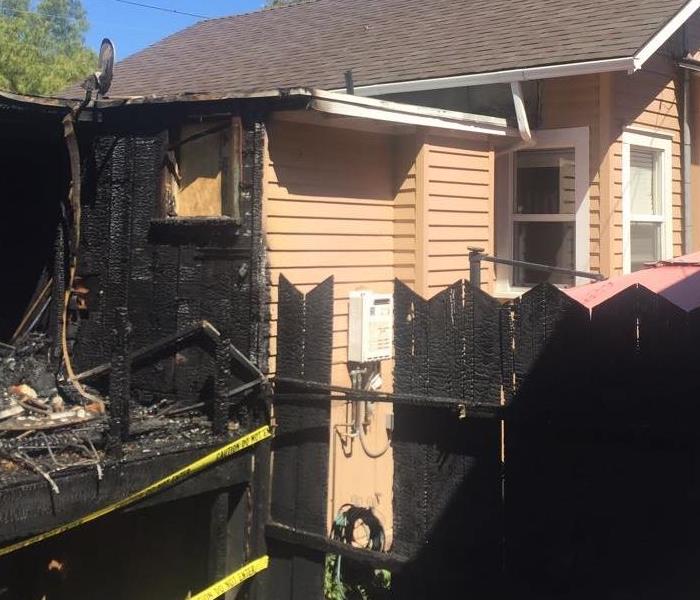 Fire Damage
Fire Damage
SERVPRO of San Luis Obispo, serving the Central Coast community since 1990, is reminding the community that it can help process insurance claims for fire, water, mold, and other disaster related damage. The San Luis Obispo fire damage company is part of the national SERVPRO Claims Information Center (CIC) that provides end-to-end insurance claims assistance. “We are uniquely positioned to provide comprehensive claims assistance because of the services we provide, including fast response to emergency calls,” said Joseph Powers, the owner of SERVPRO of San Luis Obispo. “Our 24/7 response to calls means we are first on the scene to assess the damage and start the repair and recovery process.” As a national company, SERVPRO has unique standing with the insurance industry because the company standard delivers the most extensive performance guidelines in the restoration industry. In many cases, an insurance company requires a professional damage restoration company work with the insured, when this company is a SERVPRO company, the claim process starts as soon as the SERVPRO team arrives at the scene. “The first things we do,” said Powers from the San Luis Obispo fire damage company “is inspect and assess the damage, board-up and tarp to protect the premises and contents and immediately start removing water, soot and ash.” As soon as the property is protected, the next phase of the assessment includes a room-by-room inspection with the property owner, to assess and report the details of the damage. This detailed assessment includes:
- A detailed inventory, including digital photographs
- Assistance with determining the values of items
- Determining the best method for saving the items, which may include everything from simply
- wiping down an item to drying and cleaning books, paperwork, even photographs and art
- Providing a complete report for the client and the insurance company
The entire restoration process, from start to finish involves removing all water and mold damage that may be present, removing smoke and soot, cleaning and sanitizing all restorable items, furnishings and
structures that were damaged. The next-to-final-step is helping the client file an accurate and complete insurance claim, then helping monitor the claims process. While insurance companies have representatives to work with owners to determine the extent of loss, the insurance company has processed thousands of fire damage claims. The owner has had only one fire to process and is not as clear-minded about what information is needed is as the insurance company. “Helping with the claim is a natural service for SERVPRO,” said the San Luis Obispo fire damage company owner. “It’s a natural extension of our commitment to restore peace of mind.” Powers said his company provides an invaluable service by working closely with the home and business owners and the insurance companies. “We are there, hand-in-hand with the people most effected and bring the professional expertise to support our clients through the entire process.”
What is the red retardant dropped from planes?
10/28/2020 (Permalink)
 Retardant Falling on top of houses.
Retardant Falling on top of houses.
Fire retardants are used to slow the spread or intensity of a fire. They help firefighters on the ground to control and contain a fire and help protect properties. Fire retardants may also be dropped from aircraft during firefighting operations. Sometimes a red colored pigment, made from iron oxide, is added so that those spraying can see where they have released the fire retardant.
Fire retardants consist of detergent chemicals made from a combination of wetting agents and foaming chemicals, fertilizers (ammonium and diammonium sulfate and ammonium phosphate) mixed with thickeners (guar gum) and corrosion inhibitors (for aircraft safety). They are mixed with water to form a foam or slurry. Examples include, Angus Forexpan S and Phos-Chek WD-881, Phos- Chek D75-F and Phos-Chek D75-R.
How do fire retardants work?
Fire retardants are mixed with water before they are used in the environment. After the water has completely evaporated, the remaining chemical residue retards vegetation or other materials from igniting, until it is removed by rain or erosion. Fire retardants also work by binding to plant material (cellulose) and preventing combustion.
SERVPRO of San Luis Obispo has been very experienced with this retardant in our area during the wildfires that have been occurring. We specialize in fully cleaning up the retardant which can damage the exterior of your property.
Tips on cooking a turkey for these upcoming holidays.
8/25/2020 (Permalink)
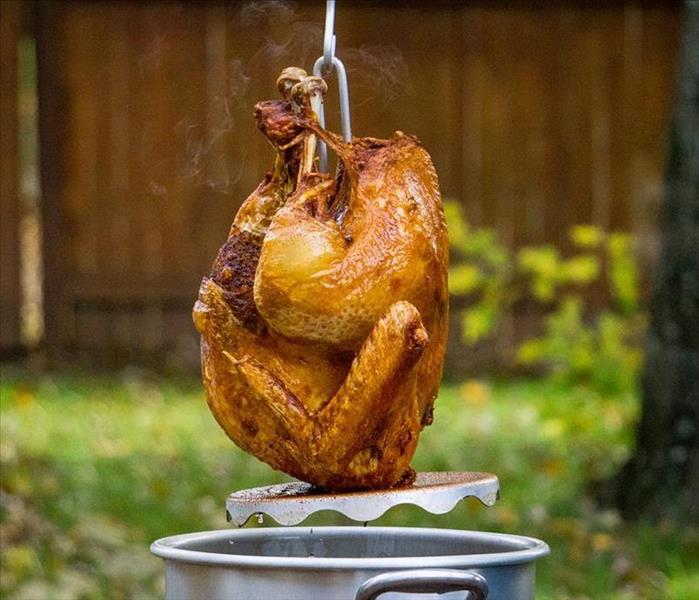 Fried Turkey
Fried Turkey
With the holidays coming up, it is time to talk about cooking a turkey. Especially, deep-fried turkey. It is really good when it is cooked this way. If you have not, well, you have not lived. Not only is it much faster to cook, but the flavor & moisture that results is amazing! With it being all great and everything it is very dangerous if it is not done properly. If not done correctly it can create a large fire. The only thing faster than deep frying a turkey is how fast your holiday can be ruined if a fire results at your home. SERVPRO of San Luis Obispo has a few tips to prevent that from happening:
- Wear protective gear. For example, eye protection thick grill gloves
- Make sure your turkey is FULLY DEFROSTED and dry before you immerse it on the oil.
- NEVER leave the fryer unattended especially if there are kids or pets around.
Here are some uncommon sources of fires.
8/5/2020 (Permalink)
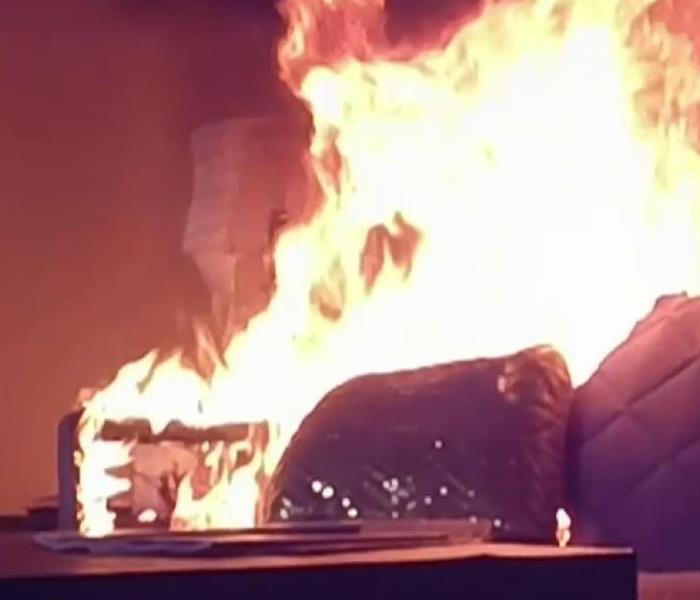 Sofa up in flames
Sofa up in flames
Many homeowners know that the most likely causes of fires can result from cooking, faulty wiring, space heaters etc. Often things are overlooked, that contribute to house fires every year.
These three uncommon things are what we least expect to cause a fire. Dusting regularly prevents any fire damage to your property because when near heat like heaters electrical outlets it can ignite a fire. Tablets and Laptops can be another source if you leave it on top of your sofa or bed where it can heat up the material it is placed on. As for the batteries they can create a fire very easily if their ends meet with one another. Instead of throwing them away in your garbage can there are certain places where they can be disposed of properly. Finally, pets are the most uncommon source that can cause fires because we are unaware that they can knock over lighted items and mistakenly turn on an appliance. Even pests who can chew through wires which can cause electrical shortages.
7 Fire Preventable Tips for your Kitchen
1/30/2020 (Permalink)
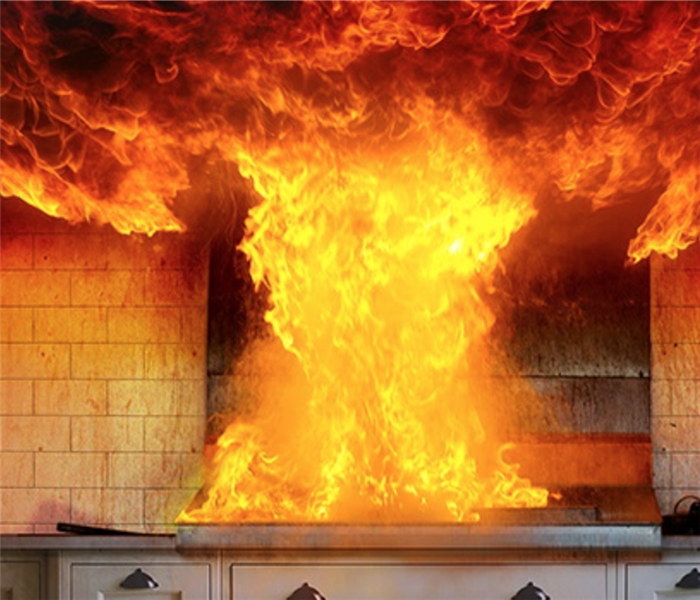 Kitchen Fire
Kitchen Fire
Cooking is truly a relaxing activity. Nothing is more therapeutic and soothing than putting all the ingredients of a special dish together and seeing it cook to perfection. People who have suffered fire accidents in the kitchen, however, can only hope to have such benign memories of their cooking experience.
According to the National Fire Protection Association, the use of cooking equipment was the leading cause of home structure fires in the United States between 2007 and 2011, accounting for 43% of all reported cases of domestic fires. Cooking fires also caused more than 2,500 deaths, over 13,200 injuries, and about $7.2 billion in property damage every year during the same period.
- Never leave your cooking unattended, even for just a few seconds. Turn off the stove if you are leaving it out of sight.
- Don’t overcook, especially if you are frying something. Cooking oil or grease can get hot very quickly.
- Never douse grease fires with water. This is very dangerous and can cause severe injuries. Cover a grease fire with a pan lid instead to deprive the fire of oxygen.
- Don’t place combustible items like paper towels, mittens, washcloths, and food packaging near the heating element of the stove.
- Keep your cooking area clean to prevent the accumulation of combustible substances like cooking oil or grease on surfaces.
- Take the time to make sure that all your kitchen appliances are turned off before you go to sleep or leave your house.
- Install a fire alarm system which can warn you promptly if a fire occurs in your kitchen.
If you have any fire damage call the professionals at SERVPRO of San Luis Obispo (805)541-1271
1 Item Every Home Should Have for Fire Prevention
1/30/2020 (Permalink)
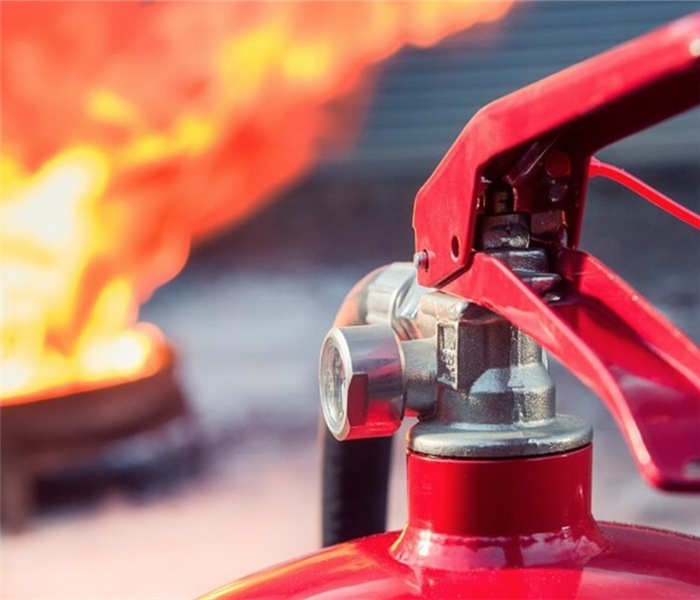 Fire Extinguisher
Fire Extinguisher
Fire Extinguishers!!!
Basically, fire extinguishers work in getting rid of fires by either snuffing out the oxygen that is responsible for combustion, cooling the temperature of the fuel feeding the fire, or halting the chemical reaction behind the fire itself. Fire extinguishers use water, a dry chemical, or carbon dioxide as agents in order to stop the progress of fire.
Fire extinguishers save lives and property by eliminating fires just before they grow too big. It is therefore important to understand how fire extinguishers work to be able to use them effectively. A working knowledge of fire extinguishers and how they are used will come in handy in the event of a fire in your home, office, or property.
If you have had any fire damage call the professionals at SERVPRO of San Luis Obispo (805)541-1271 "Like it never even happened."
The Spread of FIRE!!!
1/10/2020 (Permalink)
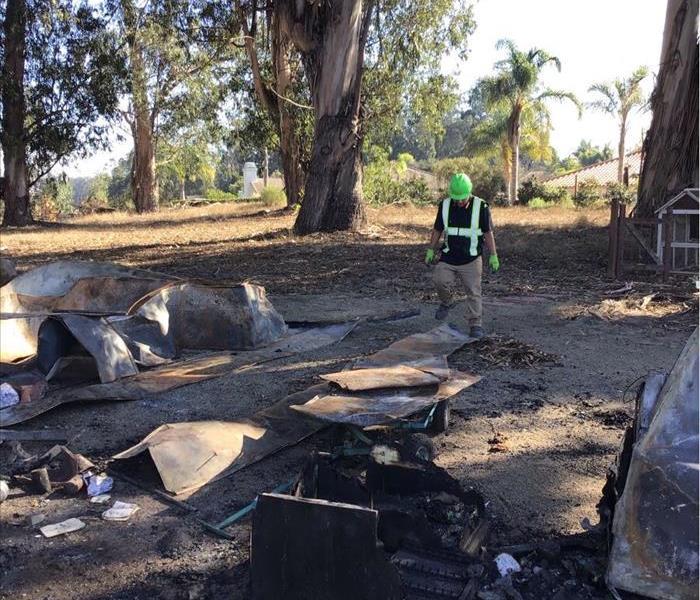 Fire Damage
Fire Damage
Do you know the four basic ways that a fire can spread?
Typically, convection, conduction, radiation, and direct burning are the four common causes for fire to spread.
1. CONVECTION- Occurs when heated liquid or gas expands and becomes lighter, oxygen flows in, igniting a chain reaction. The fire forces gases lower and the heated gases spread ceilings and walls.
2. CONDUCTION – is when heat passes through materials, Igniting fuel through other objects and combustible materials.
3. DIRECT BURNING - The easiest way a fire can spread through any structure. Any flammable materials that the fire comes in contact with has the ability to spread faster. Once the fire spreads, it can travel at a rapid rate, containment becomes very difficult.
4. RADIATION – Last but not least, radiation is the transfer of heat that becomes absorbed by materials as well as other objects. Such as, a fireplace that radiates onto carpet, mattresses or other flammable materials.
For any of your fire damage needs, call SERVPRO of San Luis Obispo "Like it never even happened."(805)541-1271
Winter Fire Hazard!
1/9/2020 (Permalink)
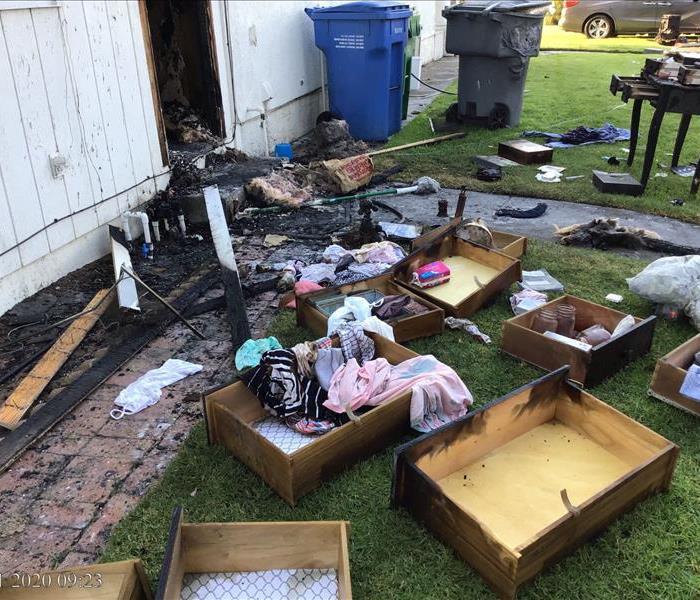 Fire Damage
Fire Damage
Cold freezing temperatures, wind, fog and rain are some of the winter elements that we encounter on the central coast. We tend to stay at home more often during the winter but did you know that most house fires happen during the winter season?
Some of the most common causes are heaters, fireplaces, candles, dry Christmas trees and even cooking/kitchen accidents. To help stay clear of any house fires here are a few tips to keep in mind:
Make sure heaters are clear of any flammable contents in case of a tip over, fireplace is clean of any debris and has a screen. Candles should be blown out every time you leave the room, Christmas trees should be disposed of properly and last but not least don't have too many cooks in the kitchen and always keep an eye on the stove.
Have a wonderful winter season but if the unexpected does occur, call SERVPRO® of San Luis Obispo (805) 541-1271 like it didn't even happen.
How to prevent a fire on Halloween.
10/10/2019 (Permalink)
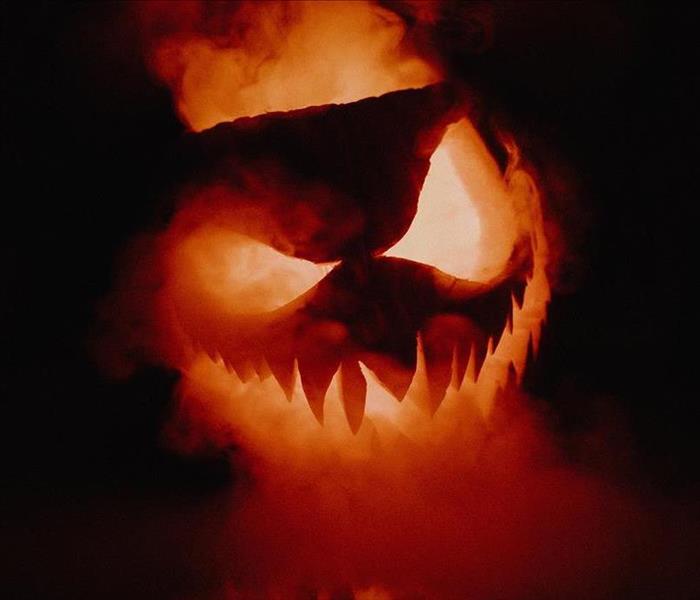
Halloween is almost here! Pumpkins are being carved, spooky decor is appearing all over the neighborhood, and costumes are getting their last-minute touches. These are just a few of the fall traditions that we look forward to every year.
Unfortunately, these Halloween symbols and activities can also present lurking fire risks that have the potential to become scary, but by planning you can help make this Halloween a fire-safe one. Taking simple fire safety precautions like keeping decorations far away from open flames and using battery-operated candles or glow-sticks in jack-o-lanterns can help ensure your holiday remains festive and fun!
“Halloween brings out the creativity in people of all ages. Children enjoy dressing up and going door-to-door collecting candy, and adults go all out decorating their homes with spooky accents,” said Lorraine Carli, NFPA’s vice president of Outreach and Advocacy. “The festivities, however, can be dampened if the proper safety measures are not put in place ahead of time and while out canvassing the neighborhood for treats.”
A fire can start when candles are too close to decorations or when long trailing costumes touch any lit candles. To make sure you have a spooky and safe Halloween, follow these tips from the National Fire Protection Association (NFPA):
• When choosing a costume, stay away from long trailing fabric. If your child is wearing a mask, make sure the eye holes are large enough so he or she can see out.
• Keep all decorations away from open flames and other heat sources like light bulbs and heaters.
• Use a battery-operated candle or glow-stick in jack-o-lanterns.
• Remember to keep exits clear of decorations, so nothing blocks escape routes.
• If your children are going to Halloween parties at others’ homes, have them look for ways out of the home and plan how they would get out in an emergency.
"Helpful tips to prevent barbecue fires."
8/20/2019 (Permalink)
Summer and fall brings family and friends together for good times over the barbecue. Great food and great company make great memories and the professionals from SERVPRO in San Luis Obispo want to make sure those memories are not marred by an out-of-control fire.
People getting together for a good time hardly seems like something that can turn into a disaster, but these interesting facts from the National Fire Protection Association can make people much more aware of barbecue safety:
- May through August is the leading months for barbecue fires.
- From 2013 to 2017 an average 19,000 people per year showed up in emergency rooms due to injuries involving barbecue grills. Children under five years old accounted for an average 2,000 injuries per year.
- Gas grills were involved in an average of 8700 home fires per year. Charcoal and other solid-fuel grills were involved in 1100 home fires per year.
- Twenty-three percent of gas grill fires were caused by leaks or breaks in the equipment.
A few precautions and a watchful eye can help keep flames and hot coals in the barbecue and away from guests, pets, dry vegetation and other flammable surroundings. Here are some tips to help prevent a fire.
- Always check the tank and connections for gas grills before starting.
- Set up the grill in a clear area outside away from flammable materials, including dry grass, trees, umbrellas and covered patios.
- Allow plenty of room for people to move around, reducing accidental contact with the hot barbecue, or even tipping it over.
- Don’t allow children and pets to play too close.
- Keep a fire extinguisher handy. A fire extinguisher can be used with gas or charcoal/wood grills. A water hose can be used with charcoal or wood grills.
- Trim excess fat. Meat that is too fatty causes flames to flare and can cause serious injury. Keep a spray bottle handy to stop flare-ups.
- Never leave fire or hot coals unattended.
- Keep the grill clean, including the cooking surfaces and grill pans.
- Check the barbecue for rust spots or holes. Make sure it is well supported with no danger of being easily knocked over. Don’t use damaged equipment.
- Let the barbecue cool down completely before covering it.
- Dump the ashes into a metal bucket and hose them down until there are completely cool with no embers of smoke before disposing of them.
The San Luis Obispo SERVPRO teams wish everyone great summer and fall good times.
SERVPRO professionals are highly trained in property damage restoration caused by fire, mold, storms and other water damage. The company mission is to help families and communities avoid personal and property damage and in the event of damage, to make it "Like it never even happened.”
Fall is Here! Don't Let Fire Safety Fall Short! Here are a Few Important Tips from SERVPRO:
10/2/2018 (Permalink)
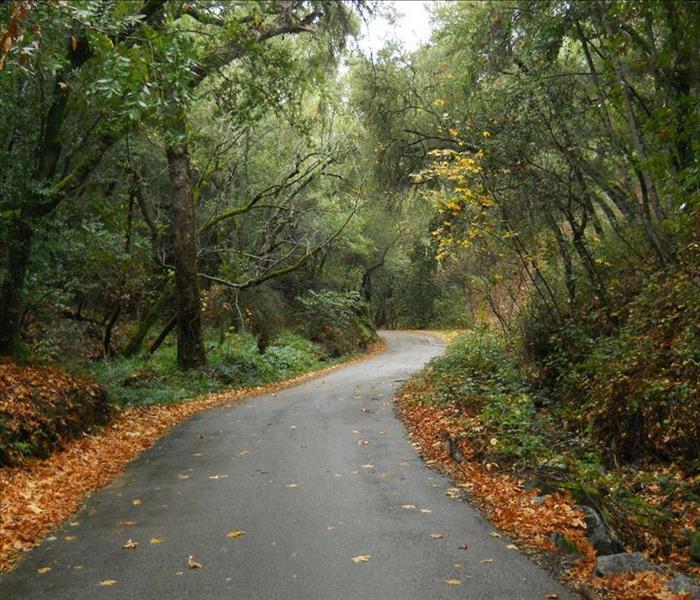 As Leaves Fall and Temperatures Drop, Autumn Brings with it Many Changes
As Leaves Fall and Temperatures Drop, Autumn Brings with it Many Changes
As cooler fall weather moves in, SERVPRO of San Luis Obispo & Atascadero reminds you to keep electrical safety in mind. Here are a few safety tips to help you stay safe as things cool down:
- Safely store warm weather tools like lawn mowers and trimmers. BE CAREFUL not to park a lawn mower or other motorized tool with a hot engine near fallen leaves as they may ignite, causing a fire.
- ALWAYS check cold weather tools, such as leaf and snow blowers, along with their power cords, for unusual wear and tear. Repair or replace worn tools or parts right away.
- ALWAYS unplug and safely store battery chargers when not in use.
- Use ONLY weatherproof electrical devices for outside activities. Protect outdoor electrical devices from moisture.
- Keep dry leaves swept AWAY from outdoor lighting, outlets and power cords.
- Make sure electric blankets are in good repair. Power cords should not be frayed, cracked or cut. If you see ANY visible damage to an electric blanket, it should be properly disposed of immediately.
- NEVER tuck an electric blanket under mattresses or children, and NEVER put anything, on top of an electric blanket while it is in use. This includes other blankets and/or comforters/bedspreads.
- The same advice re electric blankets can be said for heating pads. Heating pads and electric blankets cause almost 500 fires each year. Almost all of these fires involve electric blankets that are more than ten years old.
We at SERVPRO hope these tips help you enjoy a safe, disaster-free Autumn and beyond. Restoration after smoke, fire and water disasters may be our specialty, but we don’t wish them upon anyone. But if they occur, SERVPRO is ready for whatever happens, 24/7.
SERVPRO of San Luis Obispo Talks Turkey About the Dangers of Deep Frying
10/2/2018 (Permalink)
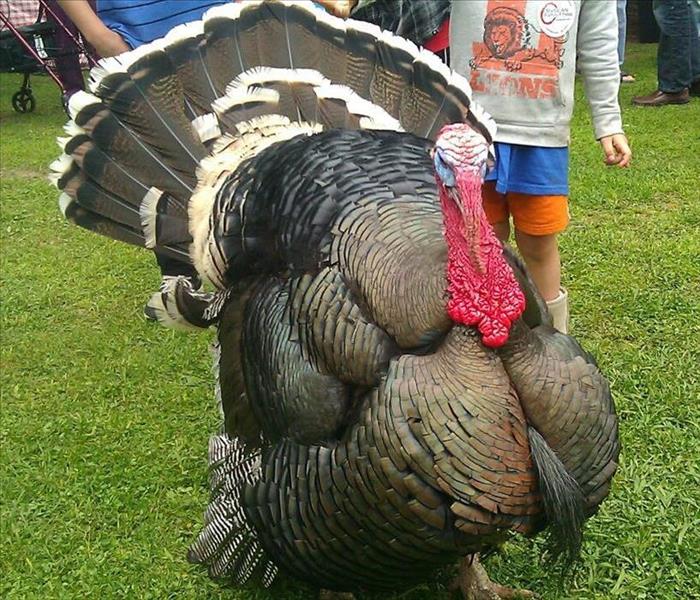 Happy Thanksgiving from all of us SERVPRO of San Luis Obispo!
Happy Thanksgiving from all of us SERVPRO of San Luis Obispo!
With Thanksgiving just around the corner, it’s time to talk turkey. Particularly, deep-fried turkey. If you’ve ever had it, you know how good it tastes. If you haven’t, well, you haven’t lived. Not only is it much faster to cook, but the flavor & moisture that results is amazing! BUT, there is some risk to preparing your bird this way, namely FIRE. The only thing faster than deep frying a turkey is how fast your holiday can be ruined if a fire results at your home. SERVPRO of San Luis Obispo has a few tips to prevent that from happening:
- Make sure the turkey isn't frozen—in fact, make sure that the turkey is COMPLETELY thawed. Oil and water do not mix. Dropping an unthawed turkey in hot oil can cause flames to ignite and spread through your home and property.
- Do NOT stuff the turkey before deep-frying or use any water-based marinades when deep-frying.
- Keep the frying at a distance—at least 10 feet away from the house, not inside any enclosures like a garage or a shed, and not under a porch or eaves.
- Keep a close watch on the deep-fryer. It only takes a moment of inattention to end up with fire damage, smoke damage, and/or even water damage if the Fire Department has to show up with their hoses!
- Keep children away from the deep-fryer. Oil burns are especially dangerous.
We at SERVPRO hope these tips help you enjoy a safe, disaster-free Thanksgiving and holiday season. Although restoration after water damage, smoke damage and fire disasters may be our specialty, we don’t wish them upon anyone. But if they occur, SERVPRO is ready for whatever happens, 24/7. Call us anytime at 805-541-1271.
Avoid Disaster! SERVPRO Offers Fire Safety Tips for Your BBQ Grilling This Summer
6/5/2018 (Permalink)
SUMMER IS HERE!!! Time to crank up that barbeque grill! Keep in mind, however, that a grill can be a fire hazard. They can be very hot, causing burn injuries. Placed too close to other flammable objects, they can become an ignition source resulting in a deck or house fire or wildfire. Follow these simple tips and you will be on the way to safe grilling.
SAFETY TIPS
- Only use propane and charcoal BBQ grills outdoors.
- Place the grill well away from the home, deck railings and out from under eaves and overhanging branches.
- Children and pets should be kept at least three feet away from the grill.
- Your grill should be kept clean by removing grease or fat buildup from the grills and in trays below the grill.
- Never leave a grill unattended—they can flare up in an instant.
- Before lighting it, always make sure your gas grill lid is open.
CHARCOAL GRILLS
- There are several ways to prepare the charcoal. Charcoal chimney starters allow you to start the charcoal using newspaper as a fuel.
- If you use a starter fluid, use only charcoal starter fluid. Never add charcoal fluid or any other flammable liquids directly to the fire. Do not EVER use gasoline.
- There are also electric charcoal starters, which do not use fire. Be sure to use an extension cord that is rated for outdoor use.
- When you are finished grilling, let the coals completely cool before disposal—always dispose of them in a metal container.
- Keep charcoal fluid away from heat sources an out of the reach of children.
PROPANE GRILLS
- Before using it for the first time each year, always check the gas tank hose for leaks. Apply a light soap and water solution to the hose. A propane leak will release bubbles. If you can smell gas, and/or if the “soapy bubble test” is actively releasing bubbles, your grill has a gas leak. If there is no flame, turn off both the gas tank and the grill. If the leak stops, get the grill serviced by a professional before using it again. If the leak does not stop, clear the area and call the fire department. If you smell gas while cooking, immediately get away from the grill and call the fire department. Do not move the grill.
- If the flame goes out, turn the grill and gas off and wait at least 5 minutes before re-lighting it.
We at SERVPRO hope these tips help you enjoy a safe, disaster-free summer and beyond. Restoration after smoke, fire and water disasters may be our specialty, but we don’t wish them upon anyone. But if they occur, SERVPRO is ready for whatever happens, 24/7.






 24/7 Emergency Service
24/7 Emergency Service










